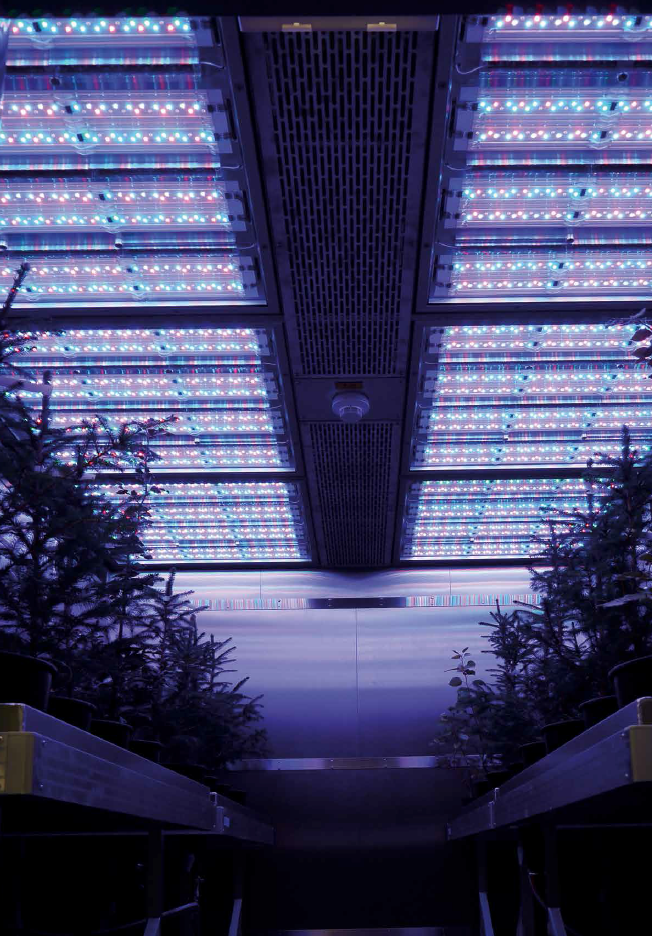Bio-Effective Lighting for Humans, Livestock and Plants
Mood lighting is often misleadingly interpreted as HCL. But HCL is much more because it includes biologically effective light that is beneficial or dangerous, depending on the correct application. While the relevant parts of the radiation spectrum may differ, light is also biologically effective for plants and animals and it is used to achieve well-defined effects. Volker Neu, General Manager LED at Vossloh-Schwabe Lighting Solutions, presents examples, discusses similarities and differences between humans, animals and plants in respect to the relevant spectra, and scrutinizes possible consequences.
In plant growth and animal farming, a lot of research is done to find opportunities to improve growth, health and productivity. In some respects even more is known about the former than about HCL. The article sets out to detail the various biological effects of identical wavelengths on plants, livestock and humans. Current knowledge about the different genera is compared and is used as inspiration to consider possible transfers to HCL (Human Centric Lighting).
The Status of Horticulture Lighting
Standardized use of bio-effective spectral lighting control has been common in the field of plant cultivation for quite some time. Industrial use is being made of available knowledge and intensive research conducted into further possible correlations. But findings delivered by fundamental research into plant behavior under different wavelengths are also available.
Stimulated via cryptochromes, phototropins and phytochrome, plants have been found to grow sturdier leaves and become more stress-tolerant at wavelengths of less than 400 nm (UV radiation). The above-named photoreceptors are active not only when subjected to this kind of shortwave radiation, but also in combination with the wavelengths displayed in the graph below. In addition, low doses of UV radiation are used as a means of protection against fungal infestation.
The wavelength range between 400 nm and 500 nm produces a series of effects but does not have to be applied in high doses. Irradiation with blue light can largely prevent plants from drying out (transpiration). In the field of household appliances, modern refrigerators are provided with blue light for the vegetable compartment, which helps to keep fruit fresh for longer.
![Chlorophyll a and Chlorophyll b absorption spectrum (a) [1], and emission spectrum of a horticulture dedicated COB LED module (b) [2]](https://www.led-professional.com/media/resources-1_articles_bio-effective-lighting-for-humans-livestock-and-plants_screen-shot-2017-03-13-at-13-52-08.png/@@images/image-1280-d11b5faeae6fe7c3b74b41cce8b1a75d.png) Figures 1a&b: Chlorophyll a and Chlorophyll b absorption spectrum (a) [1], and emission spectrum of a horticulture dedicated COB LED module (b) [2]
Figures 1a&b: Chlorophyll a and Chlorophyll b absorption spectrum (a) [1], and emission spectrum of a horticulture dedicated COB LED module (b) [2]
However, this wavelength range is also responsible for stunting longitudinal plant growth, which can lead to short intervals between leaves (dwarfism/squat plants) and thus exerts a negative effect.
Applying light within the green wavelength range (600 nm to 700 nm) counters the growth-stunting effect of blue light and prevents short intervals between foliage tiers.
Red light (700 nm to 800 nm), in turn, causes plants to produce larger blossoms and to grow in a more compact form. This wavelength range from 700 nm to 800 nm exerts a major influence on the plant, especially on the flavor of edible plants.
As a result, correctly blending these different wavelength ranges can produce light scenarios that not only facilitate perfect plant cultivation, but also yield optimization potential with regard to energy consumption and plant quality. Energy efficiency is achieved by making spectral adjustments to suit the growth phase. Multichannel systems make it possible to suppress undesired growth factors at any given point in time. Premature illumination with longwave red light will not improve root growth. However, red light – provided at the correct point in time – will allow fruit such as vine tomatoes to ripen in a targeted manner. Ensuring fruit ripens at the same point in time maximizes harvesting efficiency. However, this spectral exposure cannot be defined via an integral value for the light source. A single μmol value, without any differentiation of the radiated wavelengths, makes no sense here and can only serve as an indication of the light source’s output. For practical use, it is much better to split light into wavelength ranges and dedicated illumination tasks. This would be comparable to the integral Ra and the indices of the individual colors.
 Figure 2: The sophisticated “Lighting Equalizer”, an 11 channel system that allows spectral tuning to better control plant growth. Besides controlling growth or larger blossoms, this system offers several additional benefits
Figure 2: The sophisticated “Lighting Equalizer”, an 11 channel system that allows spectral tuning to better control plant growth. Besides controlling growth or larger blossoms, this system offers several additional benefits
 Figure 3: Horticulture lighting in a climatic chamber
Figure 3: Horticulture lighting in a climatic chamber
Current Situation in Animal Husbandry Lighting
Use of spectrally adjustable light sources is not yet as advanced in the field of animal husbandry. While some of the effects are known with regard to livestock farming, the underlying biological reasons have yet to be understood. By contrast, the use of artificial lighting in livestock housing is becoming ever more common, the reasons for which can be seen in the shift towards keeping livestock in closed sheds without daylight and the considerable global increase in the demand for meat. The demand for poultry has advanced to the number one spot worldwide and even outranks pork.
Poultry is inexpensive, healthy and quick to farm. For the seven-week period in which a chick grows into a 1.8-kg chicken, the following lighting scenarios are favored on the basis of currently available information. Green light results in good muscle growth during the first weeks of life, while blue light increases hormone production. As an orientation aid and to improve food uptake, a yellowy-white light is used. If chickens tend towards mutual pecking, red light can lower their aggression levels. A positive influence can also be exerted on the problem of cannibalism and the use of antibiotics, but tests have yet to be carried out on which exact wavelengths are involved. The shortwave range around 380 nm and the red range between 700 nm and 800 nm are set to be decisive for new findings. The visual spectrum of a chicken is considerably broader than that of a human. For that reason, they are difficult to evaluate using conventional light sources (adjusted to V(λ)). The same is true for other poultry such as ducks, geese and turkeys.
It is also worthy of note that blue light at 480 nm keeps cows awake and increases the yield of ongoing milk production by 8%. Cows have no visual ability beyond 640 nm.
A more detailed evaluation of the influence of light on pig farming has yet to be conducted, but is not currently being pursued due to current market prices.
The operating technology constitutes another factor that exerts a key influence on lighting in such applications. Lighting should feature a particularly high resistance to flickering and scintillation.
Livestock and plants process visual stimuli considerably more quickly than humans. Operation using constant current would be the best alternative and could have a positive effect on poultry and animal health overall.
For dimming purposes, the simple PWM method should not be used, but rather it should be possible to configure a “clean” pulse control factor, which would also have to be synchronized in the case of spectral (multichannel) lighting. Failure to ensure this results in stress for livestock, which in turn has a negative effect on product quality.
 Figure 4: The influence of light on poultry is quite well investigated and much is known. The image shows a common practice spectral illumination in chicken farms
Figure 4: The influence of light on poultry is quite well investigated and much is known. The image shows a common practice spectral illumination in chicken farms
Brief Comparison Between Plants, Animals & Humans
If one now compares the known and tested “plant spectra” with those currently used in animal husbandry, it is easy to see that the dominant wavelengths are largely the same. In this context, no conclusive results can be provided with regard to the amplitudes of the spectral composition.
The influence exerted by individual light spectra as a biological stimulus for humans has barely been researched. The fact that blue light (480 nm) is known to suppress melatonin production can be seen as a first relevant step towards using HCL in the field of general lighting.
The sensitivity (receptiveness) to spectral wavelengths among plants and humans is similar to that of chickens (Figure 5).
 Figure 5: Comparison of wavelengths and their effects in greenhouses, livestock and human centric lighting
Figure 5: Comparison of wavelengths and their effects in greenhouses, livestock and human centric lighting
Sunlight provides the basis for all forms of life and organisms, with only the typical respective environment affecting the individual spectra: forest and desert, hill and dale, land and water. Habitat-based filtering can produce differences in this respect.
Going by the findings yielded by research, analyses and tests in all three areas (plants, livestock and humans), it appears logical to assume that further similarities between wavelength-dependent effects will be found. For instance, in chickens the stress hormone cortisol can be reduced with “red” wavelengths. Tests involving inmates in US prisons returned comparable results.
Potential Consequences
In general, there remains a question as to the correct nomenclature for these processes and measurable factors. The human field, measured in lux and lumens, cannot be extended to wavelengths in the IR and UV ranges. Melatonin-suppression at 480 nm cannot be efficiently represented with a V(λ) curve. HCL does not fit within the conventional lighting profile. Given a typical invitation to tender, an HCL-compatible luminaire would lose out in terms of efficiency in lumens per Watt.
Tested parameters and representations used in established niche applications could provide a basis for a meaningful discussion. Since the effect of HCL on humans should be described via the degree of exposure, as for all other lifeforms and organisms, the unit of measure of this spectral range should be μmol.
However, it would be equally possible to evaluate the degree of exposure to which any one species is subjected using the sensitivity curve of the respective genus, as is already common practice in chicken farming. But would “chicken lux” or “gallus lux” apply to all species of bird?
The effect of scintillating and flickering light, which is currently being researched with regard to humans and is resulting in new and/or improved control gear, is already well known in the field of chicken farming. Operating frequencies of up to 1 kHz exert a negative influence on the health of livestock. Further organisms with a fast “visual” response include plankton and algae. This circumstance should not be underestimated for the field of general lighting. Constant-current- powered multichannel drivers could have a positive effect on the desired result, since light would be permanently available.
Conclusions
In the future, standard lighting practices currently found in the field of animal husbandry are also set to establish themselves in the area of general lighting. This also applies to arguments put forward in favor of HCL and its advantages since technical specifications would be largely transferrable. Clearly defined product features would be necessary to ensure planning security.

